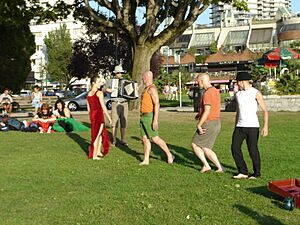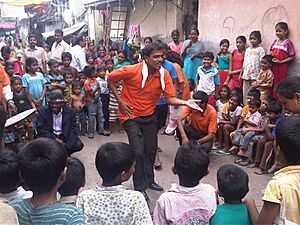Street theatre facts for kids


Street theatre is a form of theatrical performance and presentation in outdoor public spaces without a specific paying audience. These spaces can be anywhere, including shopping centres, car parks, recreational reserves, college or university campus and street corners. They are especially seen in outdoor spaces where there are large numbers of people. The actors who perform street theatre range from buskers to organised theatre companies or groups that want to experiment with performance spaces, or to promote their mainstream work. It was a source of providing information to people when there were no sources of providing information like television, radio etc. Nowadays, street play is used to convey a message to the crowd watching it. Street play is considered to be the rawest form of acting, because one does not have a microphone or loud speakers.
Sometimes performers are commissioned, especially for street festivals, children's shows or parades, but more often street theatre performers are unpaid or gather some income through the dropping of a coin in a hat by the audience.
The logistics of doing street theatre necessitate simple costumes and props, and often there is little or no amplification of sound, with actors depending on their natural vocal and physical ability. This issue with sound has meant that physical theatre, including dance, mime and slapstick, is a very popular genre in an outdoor setting. The performances need to be highly visible, loud and simple to follow in order to attract a crowd.
Street theatre should be distinguished from other more formal outdoor theatrical performances, such as performances in a park or garden, where there is a discrete space set aside (or roped off) and a ticketed audience.
In some cases, street theatre performers have to get a licence or specific permission through local or state governments in order to perform. Many performers travel internationally to certain locations of note.
Street theatre is arguably the oldest form of theatre in existence: most mainstream entertainment mediums can be traced back to origins in street performing, including religious passion plays and many other forms. More recently performers who, a hundred years ago, would have made their living working in variety theatres, music halls and in vaudeville, now often perform professionally in the many well-known street performance areas throughout the world. Notable performers that began their careers as street theatre performers include Robin Williams, David Bowie, Jewel and Harry Anderson.
Street theatre is a way to make traditional theatre accessible for those who may not be able to otherwise attend or afford tickets. The audience typically consists of anyone and everyone who wants to watch and for most performances is free public entertainment.
Reasons for staging work on the street
Performance artists with an interest in social activism may choose to stage their work on the street as a means of directly confronting or engaging the public.
Other artists consider a paying, theatre-going public to be unrepresentative of the public to whom they are trying to communicate, and performing to 'the man on the street' may be considered a more democratic form of dissemination.
Some contemporary street theatre practitioners have extensively studied pre-existing street and popular theatre traditions, such as Carnival, commedia dell'arte etc. and wish to present them in a situation close to their original context.
Whatever the reason for choosing the street, the street is a place with a different set of possibilities than the conventional theatre space. Sue Gill of Welfare State International argues that a street theatre performance is not a lesser form than an indoor performance, nor is it simply taking what you do on stage and placing it outdoors, but a form with an energy and an integrity of its own.
Many companies are politically motivated and use street theatre to combine performance with protest. This has occurred through the guerrilla theatre of San Francisco Mime Troupe, The Living Theatre, the carnivalesque parades of Bread and Puppet Theatre, and the work of Ashesh Malla and the Sarwanam Theatre Group of Nepal.
A character-based street theatre which developed in the 1960s and 1970s was developed by groups like Lumiere and Son, John Bull Puncture Repair Kit, Exploded Eye and Natural Theatre Company. The performances were unannounced and featured characters who acted out a pre-arranged scenario, looking beautiful or surreal or simply just involving passers by in conversation. They did not seek to trick in a Candid Camera way, but rather invited the audience to pretend along with them. No amount of planning or rehearsal could dictate what would happen.
Another example would be Natural Theatre's Pink Suitcase scenario. A number of smartly dressed people carrying bright pink suitcases enter a set of streets or buildings. They search for and miss their companions. In their search they get on buses, hail cabs, end up in shop windows, etc. By the time they meet up at a pre-arranged spot with the help of passers-by, perceptions of the area have changed and shopping has ceased for at least a few moments. The humour is universal and this piece has been seen in nearly seventy countries. It is usually performed by four or five actors, but has been done with twenty-five.
Interactive street theatre
Interactive street theatre is a combination of two separate art forms, street theatre and interactive art.
Unlike other interactive art, the presentation of interactive street theatre is outside in a public place and most of the time at festivals. The audience of interactive street theatre consists of passers-by who stop to participate on a voluntary basis. The nature of this type of performance is temporary, generally lasting only a few hours, and is considered much more accessible and easier to participate in than in a gallery or a museum, as those who might not have ever been to a theatre or museum can participate in interactive street theatre.
Some interactive art installations allow visitors to walk in, on, and around them, or allow them to play with the object of the installations. Another way interactive theatre is done is that spectators themselves become part of the artwork. There are also types of interactive street theatre where that spectator becomes an active part of the show and works together with the artist to create a magnificent collective art piece.
See also
 In Spanish: Teatro de calle para niños
In Spanish: Teatro de calle para niños
- Barn theatre
- Carros de foc
- Close-Act Theatre
- Freak show
- Medicine show
- One-Mensch-Theater
- Royal de luxe
- Sideshow
- Street musician



